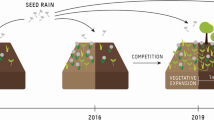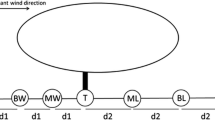Abstract
Seed movements and fates are important for restoration as these determine spatial patterns of recruitment and ultimately shape plant communities. This article examines litter cover and microsite effects on seed availability at a saline site revegetated with Eucalyptus sargentii tree rows interplanted with 5–6 rows of saltbush (Atriplex spp.). As litter accumulation decreases with increasing distance from tree rows, soil seed banks were compared between paired bare and litter-covered zones within three microsites; tree row, saltbush row closest to tree row and saltbush mid-row (middle row of saltbush between tree rows). Germinable seed banks of the four most abundant species with contrasting seed sizes and dispersal mechanisms were assessed to test the hypotheses that: (i) microsites with litter cover contain higher seed densities than bare areas, but that (ii) microsite and litter effects will vary depending on seed size and dispersal mechanisms. Overall, litter cover increased seed densities, however, litter effects varied with seed size, with no effect on small-seeded species and litter increasing densities of large-seeded species. Seed bank composition also differed between tree and shrub microsites due to differences in seed morphology and dispersal mechanisms. Water-dispersed species were unaffected by microsite but densities of wind-dispersed species, including Atriplex spp., were higher in saltbush microsites. Densities of wind-dispersed species also differed between the two saltbush microsites despite similar litter cover. Future plantings should consider row spacing and orientation, as well as the dimensions of seeding mounds and associated neighbouring depressions, to maximize litter and seed-trapping by microsites.




Similar content being viewed by others
References
Aguiar MR, Sala OE (1997) Seed distribution constrains the dynamics of the Patagonian steppe. Ecology 78:93–100
Aguiar MR, Sala OE (1999) Patch structure, dynamics and implications for the functioning of arid ecosystems. Tree 14:273–277
Anderson MJ (2001) A new method for non-parametric multivariate analysis of variance. Austral Ecol 26:32–46
Anderson MJ, Robinson J (2003) Generalised descriminant analysis based on distances. Aust N Z J Stat 45:301–318
Beadle NCW (1952) Studies in halophytes. 1. The germination and establishment of the seed and establishment of the seedlings of five species of Atriplex in Australia. Ecology 33:49–62
Beard JS (1968) Vegetation survey of Western Australia. Vegmap publications, Sydney
Biederman L, Whisenant S (2011) Using mounds to create microtopography alters plant community development early in restoration. Restor Ecol 19:53–61
Blanco-Moreno JM, Chamorro L, Masalles RM, Recasens J, Sans FX (2004) Spatial distribution of Lolium rigidum seedlings following seed dispersal by combine harvesters. Weed Res 44:375–387
Boeken B, Orenstein D (2001) The effect of plant litter on ecosystem properties in a Mediterranean semi-arid shrubland. J Veg Sci 12(6):825–832
Boeken B, Shachak M (1994) Desert plant communities in human-made patches: implications for management. Ecol Appl 4(4):702–716
Boeken B, Shachak M (1998) Colonization by annual plants of an experimentally altered desert landscape: source–sink relationships. J Ecol 86(5):804–814
Brooker I, Kleinig D (2001) Field guide to eucalypts, vol 2. Bloomings books, Melbourne
Caballero I, Olano J, Luzuriaga A, Escudero A (2005) Spatial coherence between seasonal seed banks in a semi-arid gypsum community: density changes but structure does not. Seed Sci Res 15(02):153–160
Caballero I, Olano J, Escudero A, Loidi J (2008) Seed bank spatial structure in semi-arid environments: beyond the patch-bare area dichotomy. Plant Ecol 195(2):215–223
Chambers JC (2000) Seed movements and seedling fates in disturbed sagebrush steppe ecosystems: implications for restoration. Ecol Appl 10:1400–1413
Chambers JC, MacMahon JA (1994) A day in the life of a seed: movements and fates of seeds and their implications for natural and managed systems. Ann Rev Ecol Syst 25:263–292
Chambers JC, MacMahon JA, Haefner JH (1991) Seed entrapment in alpine ecosystems: effects of soil particle size and diaspore morphology. Ecology 72:1668–1677
Dunkerley DL, Brown KJ (1999) Banded vegetation near Broken Hill, Australia: significance of surface roughness and soil physical properties. CATENA 37:75–88
Facelli JM, Temby AM (2002) Multiple effects of shrubs on annual plant communities in arid lands of South Australia. Austral Ecol 27(4):422–432
Farrell C (2007) Leaf-litter and microsite on seedling recruitment in an alley-planted E. sargentii and Atriplex spp. saline agricultural system. PhD Thesis, The University of Western Australia, Perth
Farrell C, Szota C, Hobbs RJ, Colmer TD (2011) Microsite and litter cover effects on soil conditions and seedling recruitment in a saline agricultural system. Plant Soil 348:397–409
García-Fayos P, Bochet E, Cerdà A (2010) Seed removal susceptibility through soil erosion shapes vegetation composition. Plant Soil 334:289–297
Genstat (2004) Genstat Version 7.2. Lawes Agricultural Trust, Harpenden
Ghassemi F, Jakeman AJ, Hix HA (1995) Salinisation of land and water resources; human causes, extent, management and case studies. University of NSW Press, Sydney
Gutterman Y (1981) Annual rhythm and position effect in the germinability of Mesembryanthemum nodiflorum. Isr J Bot 29:93–97
Gutterman Y (1994) Long-term seed position influences on seed germinability of the desert annual Mesembryanthemum nodiflorum L. Isr J Plant Sci 42:197–205
Gutterman Y, Golan T, Garsani M (1990) Porcupine diggings as a unique ecological system in a desert environment. Oecologia 85:122–127
Hanf M (1983) The arable weeds of Europe with their seedlings and seeds. BASF, Ludwigshafen
Hobbs RJ, Cramer VA (2003) Natural ecosystems: pattern and process in relation to local and landscape diversity in southwestern Australian woodlands. Plant Soil 257:371–378
Hoy NT, Gale MJ, Walsh KB (1994) Revegetation of a scalded saline discharge zone in Central Queensland. 1.Selection of tree species and evaluation of an establishment technique. Aust J Exp Agric 34:765–776
Hunt LP (2001) Low seed availability may limit recruitment in grazed Atriplex vesicaria and contribute to its local extinction. Plant Ecol 157:53–67
Hussey BMJ, Keighery GJ, Cousens RD, Dodd J, Lloyd SG (1997) Western weeds: a guide to the weeds of Western Australia. The Plant Protection Society of Western Australia (Inc.), Perth
Kemp P (1989) Seed banks and vegetation processes in deserts. In: Leck MA, Parker VT, Simpson RL (eds) Ecology of soil seed banks. Academic Press, New York, pp 257–281
Kok B, George PR, Stretch J (1986) Saltland revegetation with salt-tolerant shrubs. Reclam Reveg Res 5:501–507
López-Pintor A, Espigares T, Rey Benayas J (2003) Spatial segregation of plant species caused by Retama sphaerocarpa influence in a Mediterranean pasture: a perspective from the soil seed bank. Plant Ecol 167(1):107–116
Maestre F, Cortina J, Bautista S, Bellot J, Vallejo R (2003) Small-scale environmental heterogeneity and spatiotemporal dynamics of seedling establishment in a semiarid degraded ecosystem. Ecosystems 6(7):630–643
Marone L, Horno ME, del Solar RG (2000) Post-dispersal fate of seeds in the Monte desert of Argentina: patterns of germination in successive wet and dry years. J Ecol 88(6):940–949
Meissner RA, Facelli JM (1999) Effects of sheep exclusion on the soil seed bank and annual vegetation in chenopod shrublands of South Australia. J Arid Environ 42(2):117–128
Mott JJ (1973) Temporal and spatial distribution of an annual flora in an arid region of Western Australia. Trop Grassl 7:89–97
Reichman OJ (1984) Spatial and temporal variation of seed distributions in Sonoran Desert soils. J Biogeogr 11:1–11
Rotundo JL, Aguiar MR (2005) Litter effects on plant regeneration in arid lands: a complex balance between seed retention, seed longeveity and soil-seed contact. J Ecol 93:829–838
Standish R, Cramer V, Wild S, Hobbs R (2007) Seed dispersal and recruitment limitation are barriers to native recolonization of old fields in western Australia. J Appl Ecol 44(2):435–445
Standish RJ, Cramer VA, Yates CJ (2008) A revised state-and-transition model for the restoration of woodlands in Western Australia. In: Hobbs RJ, Suding KN (eds) New models for ecosystem dynamics. Island Press, Washington, DC
Tacey WH, Glossop BL (1980) Assessment of topsoil handling techniques for rehabilitation of sites mined for bauxite within the jarrah forest of Western Australia. J Appl Ecol 17:195–201
Van Oudtshoorn K, Van Rooyen M (1999) Dispersal biology of desert plants. Springer, Berlin
Wellington AB, Noble IR (1985) Seed dynamics and factors limiting recruitment of the Mallee Eucalyptus incrassata in semi-arid southeastern Australia. J Ecol 73:657–666
Whisenant SG, Thurow TL, Maranz SJ (1995) Initiating autogenic restoration on shallow semiarid sites. Restor Ecol 3(1):61–67
Yates CJ, Taplin R, Hobbs RJ, Bell RW (1995) Factors limiting the recruitment of Eucalyptus salmonophloia in remnant woodlands.2. Post-dispersal seed predation and soil seed reserves. Aust J Bot 43:145–155
Yates CJ, Hobbs RJ, Atkins L (2000) Establishment of perennial shrub and tree species in degraded Eucalyptus salmonophloia (Salmon gum) remnant woodlands: effects of restoration treatments. Restor Ecol 8:135–143
Acknowledgments
The authors would like to thank Chris Szota and Aleida Williams for invaluable assistance in the field. Thanks also to Michael and Margaret Lloyd for allowing us to work on their property. This research was funded through a PhD scholarship from The University of Western Australia and the Co-operative Research Centre (CRC) for Plant-based Management of Dryland Salinity.
Author information
Authors and Affiliations
Corresponding author
Rights and permissions
About this article
Cite this article
Farrell, C., Hobbs, R.J. & Colmer, T.D. Microsite and litter cover effects on seed banks vary with seed size and dispersal mechanisms: implications for revegetation of degraded saline land. Plant Ecol 213, 1145–1155 (2012). https://doi.org/10.1007/s11258-012-0072-y
Received:
Accepted:
Published:
Issue Date:
DOI: https://doi.org/10.1007/s11258-012-0072-y




